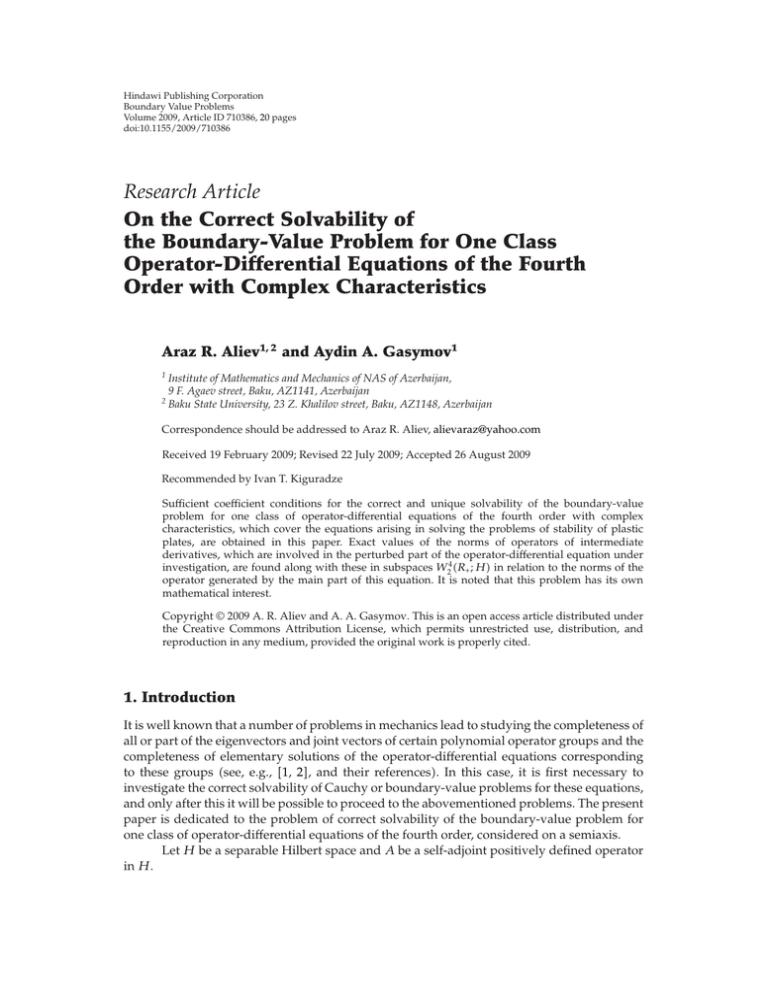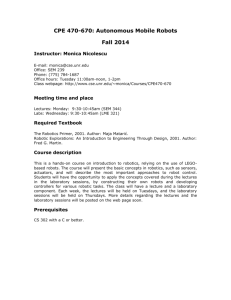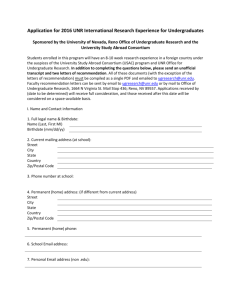Document 10841109
advertisement

Hindawi Publishing Corporation
Boundary Value Problems
Volume 2009, Article ID 710386, 20 pages
doi:10.1155/2009/710386
Research Article
On the Correct Solvability of
the Boundary-Value Problem for One Class
Operator-Differential Equations of the Fourth
Order with Complex Characteristics
Araz R. Aliev1, 2 and Aydin A. Gasymov1
1
Institute of Mathematics and Mechanics of NAS of Azerbaijan,
9 F. Agaev street, Baku, AZ1141, Azerbaijan
2
Baku State University, 23 Z. Khalilov street, Baku, AZ1148, Azerbaijan
Correspondence should be addressed to Araz R. Aliev, alievaraz@yahoo.com
Received 19 February 2009; Revised 22 July 2009; Accepted 26 August 2009
Recommended by Ivan T. Kiguradze
Sufficient coefficient conditions for the correct and unique solvability of the boundary-value
problem for one class of operator-differential equations of the fourth order with complex
characteristics, which cover the equations arising in solving the problems of stability of plastic
plates, are obtained in this paper. Exact values of the norms of operators of intermediate
derivatives, which are involved in the perturbed part of the operator-differential equation under
investigation, are found along with these in subspaces W24 R ; H in relation to the norms of the
operator generated by the main part of this equation. It is noted that this problem has its own
mathematical interest.
Copyright q 2009 A. R. Aliev and A. A. Gasymov. This is an open access article distributed under
the Creative Commons Attribution License, which permits unrestricted use, distribution, and
reproduction in any medium, provided the original work is properly cited.
1. Introduction
It is well known that a number of problems in mechanics lead to studying the completeness of
all or part of the eigenvectors and joint vectors of certain polynomial operator groups and the
completeness of elementary solutions of the operator-differential equations corresponding
to these groups see, e.g., 1, 2, and their references. In this case, it is first necessary to
investigate the correct solvability of Cauchy or boundary-value problems for these equations,
and only after this it will be possible to proceed to the abovementioned problems. The present
paper is dedicated to the problem of correct solvability of the boundary-value problem for
one class of operator-differential equations of the fourth order, considered on a semiaxis.
Let H be a separable Hilbert space and A be a self-adjoint positively defined operator
in H.
2
Boundary Value Problems
Let us consider the following operator-differential equation of the fourth order:
3
3
d
d4−s ut
d
d
−A
A ut As
ft,
Q
ut ≡
dt
dt
dt
dt4−s
s1
t ∈ R 0; ∞,
1.1
with the boundary conditions
dk u0
0,
dtk
k 0, 1, 2,
1.2
where ft ∈ L2 R ; H, ut ∈ W24 R ; H, As , s 1, 2, 3, are linear and generally
unbounded operators in H. Under L2 R ; H and W24 R ; H, the following Hilbert spaces
can be described:
L2 R ; H W24 R ; H ⎧
⎪
⎨
⎪
⎩
ft : f L2 R ;H ut : uW24 R ;H
∞
0
1/2
ft2 dt
H
< ∞ ,
⎫
⎛
⎛
⎞ ⎞1/2
⎪
∞ ⎬
2
d4 ut 2 ⎠ ⎠
4
⎝
⎝
dt
ut
<
∞
A
dt4 ⎪
H
⎭
0
H
1.3
see 3–5.
Definition 1.1. If the vector function ut ∈ W24 R ; H satisfies 1.1 almost everywhere in R , then
it is called a regular solution of 1.1.
Definition 1.2. If for any ft ∈ L2 R ; H, there exists a regular solution of 1.1 which satisfies
boundary condition 1.2 in the sense that
k
7/2−k d ut limA
0,
k
t → 0
dt H
k 0, 1, 2,
1.4
and the inequality
uW24 R ;H ≤ const f L2 R ;H
holds, then it can be said that problem 1.1, 1.2 is regularly solvable.
1.5
Boundary Value Problems
3
Let us define the following subspaces of the space W24 R ; H:
o
W24 R ; H
ut : ut ∈
W24 R ; H,
dj u0
0, j 0, 1, 2, 3 ,
dtj
o
W24 R ; H; {k} ut : ut ∈ W24 R ; H,
1.6
dk u0
0, k 0, 1, 2 .
dtk
It should be noted that the solvability theory for the Cauchy problem and the
boundary-value problems for first- and second-order operator-differential equations have
been studied in more detail elsewhere. In addition to books 6, 7, these problems have been
considered also by Agmon and Nirenberg 8, Gasymov and Mirzoev 9, Kostyuchenko
and Shkalikov 10, and in works in their bibliographies. Other papers in which issues
of the solvability of various problems for operator-differential equations of higher order
have been studied have appeared alongside these works, and sufficiently interesting results
have been obtained. Among these papers are those by Gasymov 11, 12, Dubinskii
13, Mirzoev 14, Shakhmurov 15, Shkalikov 16, Aliev 17, 18, Agarwal et al. 19,
Favini and Yakubov 20, the book by Yakubov 7, and other works listed in their
bibliographies.
Sufficient coefficient conditions for regular solvability of the boundary-value problem
stated in 1.1 and 1.2 are presented in this paper. To obtain these conditions, the main
challenge is to find the exact values of the norms of operators of intermediate derivatives in
o
o
subspaces W24 R ; H, W24 R ; H; {k}, the norms of which are expressed by the main part of
1.1. This problem has its own mathematical interest see, e.g., 21, 22, and works given in
their bibliographies. Estimation of the norms of operators of intermediate derivatives, which
are involved in the perturbed part of 1.1, is performed with the help of a factorization
method for one class of polynomial operator groups of eighth order, depending on a real
parameter. A similar approach has been presented in 9, 14, which makes it possible to
formulate solvability theorems for the boundary-value problems, with conditions which can
be easily checked.
It should be noted that if the main part of the equation has the operator in the form
2
−d /dt2 A2 , then a biharmonic equation results, which is of mathematical interest not
only theoretically, and also from a practical point of view. Many problems of elasticity
theory e.g., the theory of bending of thin elastic slabs 23 can be reduced to studying
the boundary-value problems for such equations. Much research has been performed to
investigate the solvability of such problems, for example, that reported in 24. Operatordifferential equations, which are studied in the present paper, include the fourth-order
equations which arise when solving the stability problems of plates made of plastic material
see 25, pages 185–196. It is very difficult to solve such problems because the differential
equation must be solved in a more complete form, that is, when the main part of the equation
has terms containing dut/dt and d3 ut/dt3 . As a result, the equation has more complex
characteristics, and 1.1 is of this type.
2
Furthermore, let us denote by σA the spectrum of the operator A.
4
Boundary Value Problems
2. Auxiliary Results
First, let us study the main part of 1.1:
Q0
3
d
d
d
; A ut ≡
−A
A ut ft,
dt
dt
dt
2.1
where ft ∈ L2 R ; H.
The following theorem is true.
o
k
Theorem 2.1. Operator Q0 , acting from the space W24 R ; H; {k} to L2 R ; H in the following
way:
k
Q0 ut ≡ Q0
d
; A ut,
dt
o
ut ∈ W24 R ; H; {k},
2.2
o
is an isomorphism between the spaces W24 R ; H; {k} and L2 R ; H.
o
k
Proof. It holds that Q0 ut ft has a solution ut ∈ W24 R ; H; {k} for any ft ∈
L2 R ; H. In fact, the vector function
1
vt 2π
∞
−∞
−3
−iξE A −iξE − A
−1
∞
fse−iξs ds eitξ dξ,
t ∈ R,
2.3
0
satisfies the equation
d
−A
dt
3
d
A
dt
vt ft
2.4
in R almost everywhere. Let us prove that vt ∈ W24 R; H R −∞; ∞. As is made
clear here, this means that
L2 R; H W24 R; H ⎧
⎪
⎨
ft : f L2 R;H
ut : uW24 R;H
−∞
1/2
ft2 dt
H
< ∞ ,
⎫
⎛
⎞ ⎞1/2
⎪
⎬
d4 ut 2 2
⎠ ⎠
4
⎝
.
dt
⎝
ut
<
∞
A
dt4 ⎪
H
⎭
−∞
⎛
⎪
⎩
∞
∞
H
2.5
Boundary Value Problems
5
From the Plancherel theorem, it follows that it is sufficient to show that A4 v ξ, ξ4 v ξ ∈
L2 R; H, where v ξ is the Fourier transform of the vector function vt. From the spectral
theory of self-adjoint operators,
4
A v ξ
L2 R;H
A4 −iξE A−3 −iξE − A−1 fξ
≤ A4 −iξE A−3 −iξE − A−1 L2 R;H
H →H
fξ
≤ sup σ 4 −iξ σ−3 −iξ − σ−1 fξ
L2 R;H
2.6
L2 R;H
σ∈σA
const fξ
L2 R;H
const f L2 R;H .
is the Fourier transform of the vector function ft. Analogously, it is possible to
Here fξ
prove that ξ4 v ξ ∈ L2 R; H. Consequently, vt ∈ W24 R; H. Furthermore, let us denote by
u1 t the narrowing of the vector function vt on 0; ∞. It is clear that u1 t ∈ W24 R ; H.
Now,
ut u1 t e−tA η0 tAe−tA η1 t2 A2 e−tA η2 ,
t ∈ R ,
2.7
where the vectors ηl ∈ DA7/2−l , l 0, 2, and are defined by the condition ut ∈
o
W24 R ; H; {k}. This is why the following system of equations can be obtained relatively
to ηl , l 0, 2:
u1 0 η0 0,
du1 0
− Aη0 Aη1 0,
dt
2.8
d2 u1 0
A2 η0 − 2A2 η1 2A2 η2 0.
dt2
From this, it is possible to obtain the operator equation,
MEη ζ,
2.9
where
⎛
⎞
E
0
0
⎟
⎜
⎜
0⎟
ME ⎝−E E
⎠,
E −2E 2E
⎛ ⎞
η0
⎜ ⎟
⎜
η ⎝η1 ⎟
⎠,
η2
⎛
−u1 0
⎞
⎜
⎟
⎜
⎟
⎜ −A−1 du1 0 ⎟
.
ζ⎜
dt ⎟
⎜
⎟
2
⎝
⎠
d u1 0
−A−2
dt2
2.10
Because u1 t ∈ W24 R ; H, then from the theorem on trace 3–5, Chapter 1, it follows
that all elements of the vector ζ belong to DA7/2 . Continuing this process, it is apparent
6
Boundary Value Problems
3
that the operator matrix ME is boundedly invertible in H 3 p1 H.
o
Therefore, all
ηl ∈ DA7/2 , l 0, 2. Consequently, ut ∈ W24 R ; H; {k}. In the same way, it can be
k
established that the equation Q0 ut 0 has only a trivial solution.
k
Operator Q0 is bounded, because
k 2
Q0 u
L2 R ;H
d4 u 2
4
dt L
2 R ;H
d3 u 2
4A 3 dt L2 R ;H
− 4 Re
L2 R ;H
d4 u 4
,A u
dt4
− 2 Re
− 4 Re
d4 u d3 u
,A 3
dt
dt4
4 Re
;H
du
d3 u
A 3 , A3
dt
dt
− 8 Re
2
d4 u 3 du
,A
dt
dt4
L2 R ;H
d3 u
A 3 , A4 u
dt
d4 u 2
≤ 3 4 dt L R
3 du 2
4 2
A
4
u
A
dt L2 R ;H
L2 R ;H
L2 R ;H
L2 R ;H
L2 R ;H
du
4 Re A3 , A4 u
dt
L2 R ;H
d3 u 2
6A 3 dt L2 R ;H
d2 u 2
2
6A
dt2 L2 R ;H
2
3 du 2
A
4
A4 u
dt L2 R ;H
L2 R ;H
≤ const u2W 4 R ;H ,
2
2.11
o
because for ut ∈ W24 R ; H; {k}
2 Re
2 Re
d4 u 3 du
,A
dt
dt4
d3 u
du
A 3 , A3
dt
dt
0,
2 Re
L2 R ;H
L2 R ;H
d 2 u 2
2
−2A
dt2 d4 u 4
,A u
dt4
L2 R ;H
,
2 Re
L2 R ;H
du
2 Re A3 , A4 u
0.
dt
L2 R ;H
d2 u 2
2
2A
dt2 ,
L2 R ;H
d3 u
A 3 , A4 u
dt
0,
L2 R ;H
2.12
Boundary Value Problems
7
The theorem on intermediate derivatives 3–5, Chapter 1 can be used to obtain the last
inequality, with the inequality
d4−j u j
A
dt4−j L2 R ;H
≤ cj uW24 R ;H ,
j 0, 4,
2.13
assumed. Moreover, the Bunyakovsky-Schwartz and Young inequalities,
Re
d4 u d3 u
,A 3
dt
dt4
L2 R ;H
d4 u ≤ 4
dt L R
2
;H
2
4 1
d u
≤ 4
2 dt L R
2
d3 u A 3 dt L2 R ;H
;H
2
3 1
d u
A 3 2 dt 2.14
,
L2 R ;H
are used in the expression Re d4 u/dt4 , Ad3 u/dt3 L2 R ;H .
k
o
is bounded and acts mutually and uniquely from the space
As a result, Q0
W24 R ; H; {k} to the space L2 R ; H. Then, taking into account the Banach theorem on
k
the inverse operator, it can be established that the operator Q0 carries out the isomorphism
o
from the space W24 R ; H; {k} to L2 R ; H. Thus, the theorem is proved.
k
Denoting by Q1
following way:
o
the operator which acts from W24 R ; H; {k} to L2 R ; H in the
k
Q1 ut ≡
3
As
s1
d4−s ut
,
dt4−s
o
ut ∈ W24 R ; H; {k},
2.15
the following statement results.
k
Lemma 2.2. Let As A−s , s 1, 2, 3, be bounded operators in H. Then the operator Q1 is a bounded
o
operator from W24 R ; H; {k} to L2 R ; H.
o
Proof. Because for any vector function ut ∈ W24 R ; H; {k},
k Q1 u
L2 R ;H
≤
4−s ds u A
,
H →H
dts L2 R ;H
3 A4−s A−4s s1
2.16
8
Boundary Value Problems
then, from the theorem on intermediate derivatives 3–5, Chapter 1, and from 2.16, we get
k Q1 u
L2 R ;H
≤ const uW24 R ;H .
2.17
Thus, the lemma is proved.
Now certain properties of polynomial operator groups will be investigated, which will
have in the future a special role.
Let the following hold:
as 1 s
s 4 − s4−s ,
256
s 1, 2, 3.
2.18
Consider the following polynomial operator groups which depend on the parameter α ∈
0; a−1
s , s 1, 2, 3:
4
Qs λ; α; A λ2 E − A2 − αiλ2s A8−2s ,
s 1, 2, 3
2.19
The following can then be established.
Lemma 2.3. Let α ∈ 0; a−1
s , s 1, 2, 3. Then the polynomial operator groups Qs λ; α; A, s 1, 2, 3, are invertible on the imaginary axis and can be represented as follows:
Qs λ; α; A Fs λ; α; AFs −λ; α; A,
s 1, 2, 3;
2.20
moreover,
Fs λ; α; A 4
λE − ωs,n αA
n1
2.21
≡ λ4 E d1,s αλ3 A d2,s αλ2 A2 d3,s αλA3 A4 ,
where Re ωs,n α < 0, n 1, 2, 3, 4, and the numbers d1,s α, d2,s α, d3,s α satisfy the following
systems of equations:
1 for k 1
2
−d1,1
α 2d2,1 α 4 0,
2
d2,1
α − 2d1,1 αd3,1 α − 4 0,
2
−d3,1
α 2d2,1 α 4 α;
2.22
Boundary Value Problems
9
2 for k 2
2
2d2,2 α − d1,2
α 4 0,
2.23
2
d2,2
α − 2d1,2 αd3,2 α − 4 −α,
2
−d3,2
α 2d2,2 α 4 0;
3 for k 3
2
−d1,3
α 2d2,3 α 4 α,
2.24
2
d2,3
α − 2d1,3 αd3,3 α − 4 0,
2
−d3,3
α 2d2,3 α 4 0.
Proof. Characteristic polynomials of the operator groups Qs λ; α; A, s 1, 2, 3, are
4
Qs λ; α; σ λ2 − σ 2 − αiλ2s σ 8−2s ,
s 1, 2, 3,
2.25
where σ ∈ σA. Let λ iξ, ξ ∈ R −∞; ∞. Then it is clear that for these characteristic
polynomials, the following correlations are true:
Qs λ; α; σ Qs iξ; α; σ
σ
8
≥σ
8
4 s
ξ2
ξ2 /σ 2 1−α
1
4
σ2
ξ2 /σ 2 1
4 ξ2
1
σ2
1 − α sup
ξ2 /σ 2 ξ2 /σ 2 ≥0 ξ 2 /σ 2
2.26
s
14
,
s 1, 2, 3.
Because
s
sup
ξ2 /σ 2 ξ2 /σ 2 ≥0 ξ 2 /σ 2
14
as ,
s 1, 2, 3,
2.27
then
Qs iξ; α; σ > 0
2.28
for α ∈ 0; a−1
s , s 1, 2, 3. From 2.28, it becomes clear that the polynomials Qs λ; α; σ do
not have roots on the imaginary axis for α ∈ 0; a−1
s , s 1, 2, 3. Each of the characteristic
polynomials Qs λ; α; σ for σ ∈ σA has exactly four roots from the left semiplane. Because
10
Boundary Value Problems
these polynomials are homogeneous with respect to the arguments λ and σ, they can be stated
in the following form:
Qs λ; α; σ Fs λ; α; σFs −λ; α; σ,
s 1, 2, 3,
2.29
where
Fs λ; α; σ 4
λ − ωs,n ασ
2.30
n1
≡ λ4 d1,s αλ3 σ d2,s αλ2 σ 2 d3,s αλσ 3 σ 4 ,
and moreover Re ωs,n α < 0, n 1, 2, 3, 4, and the numbers d1,s α, d2,s α, d3,s α satisfy
the systems of equations shown in Lemma 2.3, which are obtained from 2.29 in the process
of comparing the coefficients for the same degrees. Then, from the spectral decomposition
of operator A, the proof of the lemma can be obtained from 2.29. Thus, the lemma is
proved.
The next step is to prove the theorem, which will play an important role in future
investigations and will show the special importance of the spectral properties of the
polynomial operator groups Qs λ; α; A and Fs λ; α; A, s 1, 2, 3.
4
Theorem 2.4. Let α ∈ 0; a−1
s . Then for any ut ∈ W2 R ; H, the following equality is true:
3 d
2
d
−
A
A
u
dt
dt
4−s ds u 2
A
− α
dts L2 R ;H
L2 R ;H
2.31
2
!
d
F
;
α;
A
u
Rs αϕ, ϕ H 4 ,
s dt
L2 R ;H
where
H4 4
"
H,
p1
⎛
d3,s α − 2
d1,s α 2
d2,s α
2
⎞
⎜
⎟
⎜ d2,s α d2,s αd3,s α − d1,s α − 2
d1,s αd3,s α 2
d3,s α 2⎟
⎜
⎟
Rs α ⎜
⎟,
⎜d1,s α 2
d1,s αd3,s α 2
d1,s αd2,s α − d3,s α − 2 d2,s α ⎟
⎝
⎠
2
d3,s α 2
d2,s α
d1,s α − 2
ϕ
ϕl A
4−l−1/2 d
l
u0
dtl
3
.
l0
2.32
Boundary Value Problems
11
Proof. First define the space D4 R ; H as the set of infinitely differentiable functions with
values in DA4 , having compact support in R . Because the space D4 R ; H is dense in
W24 R ; H see 3–5, Chapter 1, it is sufficient to prove the theorem for the vector functions
ut ∈ D4 R ; H. Then
2
Fs d ; α; A u
dt
L2 R ;H
d4 u 2
4
dt L R
2
;H
d3 u 2
2
d1,s αA 3 dt L2 R ;H
3 du 2
2
d3,s αA
dt L2 R ;H
2 Re
L2 R ;H
2d1,s α Re
2d3,s α Re
L2 R ;H
d4 u 4
,A u
dt4
2d1,s αd2,s α Re
L2 R ;H
du
d3 u
A 3 , A3
dt
dt
2d1,s αd3,s α Re
2d
2
d4 u 3 du
,A
dt
dt4
2d
2
L2 R ;H
L2 R ;H
2.33
L2 R ;H
2d1,s α Re
L2 R ;H
d3 u
A 3 , A4 u
dt
L2 R ;H
u 4
,A u
A
dt2
d2 u
d3 u
A 3 , A2 2
dt
dt
u 3 du
,A
A
dt
dt2
2d2,s αd3,s α Re
d4 u d3 u
,A 3
dt
dt4
2d2,s α Re
2
A4 u
d4 u 2 d2 u
,A
dt2
dt4
2d2,s α Re
d2 u 2
2
2
d2,s αA
dt2 L2 R ;H
L2 R ;H
L2 R ;H
du
2d3,s α Re A3 , A4 u
.
dt
L2 R ;H
After integration by parts,
2
d4 u 2
d
Fs
; α; A u
4
dt
dt
L2 R ;H
2
d1,s
α
L2 R ;H
d3 u 2
− 2d2,s α A 3 dt L
2 R ;H
2
3 du 2
2
A
d3,s
A4 u
α − 2d2,s α dt L2 R ;H
L2 R ;H
2 − 2d1,s αd3,s α 2
d2,s
α
d2 u 2
2
A
dt2 L
2 R ;H
12
Boundary Value Problems
2
!
− d1,s αϕ3 − 2d2,s α Re ϕ3 , ϕ2
2
d3,s α − d1,s αd2,s αϕ2 !
!
− 2d3,s α Re ϕ3 , ϕ1 − 2 Re ϕ3 , ϕ0
!
!
2 − 2d1,s αd3,s α Re ϕ2 , ϕ1 − 2d1,s α Re ϕ2 , ϕ0
2
d1,s α − d2,s αd3,s αϕ1 2
!
− 2d2,s α Re ϕ1 , ϕ0 − d3,s αϕ0 .
2.34
2
Calculating d/dt − Ad/dt A3 uL2 R ;H analogously to Fs d/dt; α; Au2L2 R ;H ,
3 2
d
d
−A
A u
dt
dt
L2 R ;H
d4 u 2
4
dt L R
2
;H
d3 u 2
4A 3 dt L2 R ;H
d2 u 2
2
6A
dt2 L2 R ;H
2
3 du 2
2
4A
A4 u
− 2ϕ3 L2 R ;H
dt L2 R ;H
2
!
!
− 2ϕ2 4 Re ϕ3 , ϕ1 2 Re ϕ3 , ϕ0
2
2
!
!
6 Re ϕ2 , ϕ1 4 Re ϕ2 , ϕ0 − 2ϕ1 − 2ϕ0 .
2.35
Substituting 2.35 into 2.34, from Lemma 2.3, 2.31 can be obtained. Thus, the theorem is
proved.
From Theorem 2.4, it follows that:
o
Corollary 2.5. If ut ∈ W24 R ; H and α ∈ 0; a−1
s , then
3 2
d
d
−A
A u
dt
dt
L2 R ;H
2
4−s ds u 2
d
; α; A u
− αA
Fs
.
dts L2 R ;H dt
L2 R ;H
k
o
2.36
Note that from Theorem 2.1, Q0 uL2 R ;H is the norm in the space W24 R ; H; {k},
which is equivalent to the initial norm uW24 R ;H . Because the operators of the intermediate
Boundary Value Problems
13
derivatives
A4−s
o
ds
4
:
W
2 R ; H; {k} −→ L2 R ; H,
dts
s 1, 2, 3,
2.37
are continuous 3–5, Chapter 1, then the norms of these operators can be estimated
k
using Q0 uL2 R ;H . It is also easy to demonstrate that the norms uW24 R ;H and
o
d/dt − Ad/dt A3 uL2 R ;H are equivalent in the space W24 R ; H.
3. Norms of the Operators of Intermediate Derivatives
The rest of this paper will be related to the calculation of the following numbers:
m0,s sup
o
3 −1
d
4−s ds u d
A
−A
A u
dts L2 R ;H dt
dt
mk,s sup
o
0
/ u∈W24 R ;H;{k}
,
L2 R ;H
0/
u∈W24 R ;H
3 −1
d
4−s ds u d
A
−A
A u
dts L2 R ;H dt
dt
3.1
.
L2 R ;H
First, let us calculate m0,s .
Lemma 3.1. It holds that m0,s a1/2
s , s 1, 2, 3.
Proof. As 2.36 goes to the limit as α → a−1
s , it is apparent that for any vector function
o
ut ∈ W24 R ; H, the following inequality:
3 2
d
d
−A
A u
dt
dt
≥
L2 R ;H
s 2
−1 4−s d u as A
dts L2 R ;H
3.2
is true. Thus, m0,s ≤ a1/2
s , s 1, 2, 3. Furthermore, it is necessary to show that here the
1/2
equalities m0,s as , s 1, 2, 3 also hold. This can be done by taking an arbitrary number
o
δ > 0 and showing that there exists a vector function uδ t ∈ W24 R ; H such that the
following holds functional:
3 d
2
d
−A
A uδ Λuδ ≡ dt
dt
L2 R ;H
−
a−1
s
4−s ds uδ 2
δ A
< 0.
dts L2 R ;H
3.3
14
Boundary Value Problems
Let the vector ς ∈ DA8 and ς 1, ht be the numeral function; moreover, htς ∈
Then using the Parseval equality, it is possible to obtain
W24 R; H.
2
3
d
d
Λhtς −A
A htς
dt
dt
∞ #
−∞
L2 R;H
4−s ds ht 2
A
− a−1
δ
ς
s
dts L2 R;H
$
2
2
2s
4−s
4−s
A
δ
ξ
ς,
A
ς
hξ
Q0 −iξ; Aς, Q0 −iξ; Aςhξ
− a−1
dξ
s
∞ −∞
∞
−∞
2
2s 8−2s
Q0 −iξ; AQ0 −iξ; Aς − a−1
ς, ς hξ
dξ
s δ ξ A
2
φξ; ςhξ
dξ,
3.4
where φξ; ς Qs iξ; a−1
s δ; Aς, ς.
It will next be shown that φξ; ς for a given vector ς has negative values in some
interval ε0 ; ε1 . If μ0 is an eigenvalue of the operator Aμ0 > 0, and if ς is its eigenvector,
then it is obvious that
−1
φξ; ς Qs iξ; a−1
s δ; A ς, ς Qs iξ; as δ; μ0 ς, ς ,
3.5
and, as can be seen from the properties of the polynomial Qs iξ; α; μ0 , is negative for α a−1
s δ for sufficiently small δ > 0. If μ0 ∈ σA is not the eigenvalue, then μ0 is close to an
eigenvalue, that is, there exists ςδ such that ςδ 1 and
φξ; ςδ Qs iξ; a−1
s δ; μ0 ςδ oδ
as δ −→ 0,
3.6
because in this case, for sufficiently small δ, the smallest value is negative for some ςδ . Then
there exists an interval ε0 ; ε1 such that φξ; ς < δ for ξ ∈ ε0 ; ε1 .
Now consider the four times differentiable function hξ,
support of which comes from
the interval ε0 ; ε1 . Then from 3.4 and from the negativity of φξ; ςδ in the interval ε0 ; ε1 ,
it can be determined that
Λhtςδ ε1
2
φξ; ςδ hξ
dξ < 0.
ε0
Consequently, m0,s a1/2
s , s 1, 2, 3, and the lemma is proved.
3.7
Boundary Value Problems
o
15
o
Because W24 R ; H ⊂ W24 R ; H; {k}, then mk,s ≥ m0,s a1/2
s , s 1, 2, 3. It is
o
necessary to note that, for any vector function ut ∈ W24 R ; H; {k} and α ∈ 0; a−1
s , the
equality
3 2
d
d
−A
A u
dt
dt
L2 R ;H
4−s ds u 2
A
− α
dts L2 R ;H
3.8
2
!
d
F
;
α;
A
u
Rs α; kϕ,
ϕ H
s
dt
L2 R ;H
is true, where Rs α; k d1,s α−2 is obtained from Rs α by removing the first three rows and
columns, ϕ A1/2 d3 u0/dt3 . The correctness of 3.8 follows directly from Theorem 2.4.
The following statement indicates when the numbers mk,s , s 1, 2, 3, can be equal to
1/2
as , s 1, 2, 3.
Lemma 3.2. To establish the condition mk,s a1/2
s , it is necessary and sufficient that Rs α; k be
.
positive for any α ∈ 0; a−1
s
Proof. Necessity will be shown first. Let mk,s a1/2
s . Then, from 3.8, for any vector function
o
ut ∈ W24 R ; H; {k} and α ∈ 0; a−1
s ,
2
3 d
2
!
d
Fs d ; α; A u
−A
A u
Rs α; kϕ,
ϕ H ≥ dt
dt
dt
L2 R ;H
L2 R ;H
1−αm2k,s > 0.
3.9
Because the polynomial operator group Fs λ; α; A for α ∈ 0; a−1
s has the form
Fs λ; α; A 4
λE − ωs,n αA
3.10
n1
see Lemma 2.3, where Re ωs,n α < 0, n 1, 2, 3, 4, then the Cauchy problem,
Fs
d
; α; A ut 0,
dt
dk u0
0,
dtk
k 0, 1, 2,
d3 u0
A−1/2 ϕ,
dt3
ϕ ∈ H,
3.11
3.12
3.13
has a unique solution uα t ∈ W24 R ; H, which can be presented in the form
uα t eωs,1 αtA ψ0 eωs,2 αtA ψ1 eωs,3 αtA ψ2 eωs,4 αtA ψ3 ,
3.14
16
Boundary Value Problems
where ψ0 , ψ1 , ψ2 , ψ3 ∈ DA7/2 are uniquely determined from the conditions at zero in
3.12 and 3.13. As a result, writing inequality 3.9 for the vector function uα t, for
ϕ
H > 0. Necessity is thereby proved.
α ∈ 0; a−1
s Rs α; kϕ,
Now sufficiency must be proved. If for any α ∈ 0; a−1
s , Rs α; k is positive, then from
o
3.8, it follows that for all ut ∈ W24 R ; H; {k} and α ∈ 0; a−1
s ,
3 2
d
d
−A
A u
dt
dt
L2 R ;H
4−s ds u 2
A
≥ α
.
dts L2 R ;H
3.15
1/2
As this expression goes to the limit as α → a−1
s , it can be observed that mk,s ≤ as , and from
1/2
this, mk,s as . Sufficiency is thereby proved, and thus the lemma is completely proved.
It is interesting that for some s, it may occur that mk,s > a1/2
s .
Lemma 3.3. It holds that mk,s > a1/2
if and only if Rs α; k 0 has a solution in the interval
s
−2
;
moreover,
this
root
is
equal
to
m
.
0; a−1
s
k,s
−2
−2
−1
Proof. Let mk,s > a1/2
s , then mk,s ∈ 0; as . From 3.8, for α ∈ 0; mk,s ,
2
3 d
2
!
d
d
Fs
;
α;
A
u
−A
A
R
≥
u
k
ϕ,
ϕ
α;
s
H dt
dt
dt
L2 R ;H
L2 R ;H
1−αm2k,s > 0.
3.16
Substituting the solution of 3.11–3.13 into the last inequality, the result is that
Rs α; k is positive for α ∈ 0; m−2
. From the definition of mk,s , for α ∈ m−2
; a−1 , there
k,s
k,s s
o
exists a vector function vα t ∈ W24 R ; H; {k} such that
3 2
d
d
−A
A vα dt
dt
L2 R ;H
4−s ds vα 2
A
< α
.
dts L2 R ;H
3.17
From the last inequality in 3.8, it is possible to obtain
2
!
Fs d ; α; A vα Rs α; kϕα , ϕα H < 0,
dt
L2 R ;H
3.18
where
ϕα A1/2
d3 vα 0
.
dt3
3.19
Thus, there exists a vector ϕα ∈ H such that for α ∈ m−2
; a−1 , Rs α; kϕα , ϕα H < 0. Because
k,s s
−2
Rs α; k is a continuous function of the argument α ∈ 0; a−1
s , then Rs mk,s ; k 0, and this
means that Rs α; k 0 has a root in the interval 0; a−1
s .
Boundary Value Problems
17
Inversely, if Rs α; k 0 has a root in the interval 0; a−1
s , then this means that for any
α ∈ 0; a−1
,
the
number
R
α;
k
cannot
be
positive.
This
is
why,
from Lemma 3.2, mk,s > a1/2
s
s .
s
−2
Denoting the root of Rs α; k 0 by μk,s , it can be seen that mk,s ≤ μk,s , because from the proof
, Rs α; k is positive. Moreover, because
of the lemma, it was obtained that for α ∈ 0; m−2
k,s
−2
−2
Rs mk,s ; k 0, it can be determined that mk,s μk,s . The lemma is thereby proved.
By generalizing the last two lemmas, the following theorem can be derived.
Theorem 3.4. The following equality is true:
mk,s ⎧
⎨a1/2
s
!
!
for Rs γ; k / 0, γ ∈ 0; a−1
s ,
⎩μ−1/2
otherwise.
k,s
3.20
Remark 3.5. In the same way, it is possible to determine the results for boundary-value problems of the
form 1.1, 1.2 for k having any three values from the collection {0; 1; 2; 3}.
By considering concretely the cases s, the following statement results.
√
√
Theorem 3.6. mk,1 1/ 3; mk,2 1/2 3; mk,3 a1/2
3 .
Proof. Taking into account the abovementioned procedure for finding the numbers mk,s , it
is necessary to solve the systems from the proof of Lemma 2.3 together with the equation
Rs α; k 0.
In the case s 1, it can be determined
that d1,1 α 2 ⇒ d2,1 α 0 ⇒ d3,1 α −1 ⇒
√
.
This
is
why
m
1/
3.
To
find the number mk,2 , it is necessary to solve
α 3 ∈ 0; a−1
k,1
1
the system from Lemma 2.3 for s 2 together with the equation d1,2 α − 2 0. In this case,
−1
∈ 0; a−1
d1,2 α 2, d2,2 α 0, d
2 .
√3,2 α ±2, and consequently α 12 ∈ 0; a2 and α −4 /
As a result, mk,2 1/2 3. In the case s 3, it is found that d1,3 α 2. Then, from the
4
2
α − 8d2,3
α − 32d2,3 α −
corresponding system, it can be obtained that 2d2,3 α α and d2,3
3
2
48 0 or d2,3 α2d2,3 α−2d2,3 α−4d2,3 α−24 0. It is clear that d2,3 α −2 ⇒ d3,3 α 3
2
0 ⇒ α −4 /
∈ 0; a−1
3 . From the other side, if in the equation d2,3 α−2d2,3 α−4d2,3 α−24 0,
3
2
it is assumed that 2d2,3 α %α, then the result is that
α − 4α − 16α − 192 0, which has
%
√
√
3
3
∈ 0; a−1
only one real root, α 1/3 −2944 2 2113423− 2944 2 2113423 /
3 . Therefore,
1/2
mk,3 a3 , and the theorem is proved.
4. Solvability Conditions for the Boundary-Value Problem 1.1, 1.2
The results obtained make it possible to determine sufficient coefficient conditions of regular
solvability for the boundary-value problem 1.1, 1.2. In particular, the following main
theorem is true.
18
Boundary Value Problems
Theorem 4.1. Let the operators As A−s , s 1, 2, 3, be bounded in H so that the inequality
mk,1 A1 A−1 H →H
mk,2 A2 A−2 H →H
mk,3 A3 A−3 H →H
4.1
<1
is satisfied, where the numbers mk,s , s 1, 2, 3, are as defined in Theorem 3.6. Then the boundaryvalue problem 1.1, 1.2 is regularly solvable.
Proof. The boundary-value problem 1.1, 1.2 can be presented in the form of the operator
k
o
k
equation Q0 ut Q1 ut ft, where ft ∈ L2 R ; H, ut ∈ W24 R ; H; {k}. From
k−1
k
Theorem 2.1, it follows that the operator Q0 has a bounded inverse operator Q0
which
o
acts from the space L2 R ; H into the space W24 R ; H; {k}. Then, after substitution of
k−1
k
k−1
ut Q0 vt, where vt ∈ L2 R ; H, the equation E Q1 Q0 vt ft results.
Now it must be shown that whenever the conditions of the theorem are met, the norm of the
k k−1
is less than one. Assuming Theorem 3.6, the following can be obtained:
operator Q1 Q0
k k−1 Q1 Q0 v
k Q1 u
L2 R ;H
L2 R ;H
d3 u ≤ A1 3 dt L2 R ;H
d2 u A2 2 dt d3 u −1 ≤ A1 A A 3 H →H
dt du A3 dt L2 R ;H
L2 R ;H
d2 u 2
A
H →H
dt2 A2 A−2 L2 R ;H
4.2
L2 R ;H
3 du A
H →H
dt L2 R ;H
≤ mk,1 A1 A−1 mk,2 A2 A−2 mk,3 A3 A−3 k Q0 u
mk,1 A1 A−1 mk,3 A3 A−3 A3 A−3 H →H
H →H
H →H
mk,2 A2 A−2 H →H
H →H
H →H
L2 R ;H
υL2 R ;H .
As a result:
k k−1 Q1 Q0 L2 R ;H → L2 R ;H
≤ mk,1 A1 A−1 H →H
mk,3 A3 A−3 mk,2 A2 A−2 H →H
k
H →H
4.3
< 1.
k−1
has an inverse in the space L2 R ; H, and it is
Then, in this case, the operator E Q1 Q0
possible to determine ut from the following formula:
k−1
ut Q0
k
k−1
E Q1 Q0
−1
ft.
4.4
Boundary Value Problems
19
Moreover,
uW24 R ;H
−1 −1 E Qk Qk
0
1
L2 R ;H → W 4 R ;H k−1 ≤ Q0 L2 R ;H → L2 R ;H
2
≤ const f L2 R ;H .
f L2 R ;H
4.5
Thus, the theorem is proved.
Remark 4.2. The conditions of regular solvability obtained here for the boundary-value
problem 1.1, 1.2 are not improvable in terms of the operator coefficients of 1.1.
Following is an example in which the conditions of Theorem 4.1 are verified. Consider
the following problem on the semi-axis R × 0; π:
∂
∂2
2
∂t ∂x
∂
∂2
− 2
∂t ∂x
3
∂k u0, x
0,
∂tk
ut, x p1 x
k 0, 1, 2,
∂5 ut, x
∂6 ut, x
∂7 ut, x
ft, x
p
p
x
x
2
3
∂x2 ∂t3
∂x6 ∂t
∂x4 ∂t2
∂2i ut, 0 ∂2i ut, π
0,
∂x2i
∂x2i
i 0, 1, 2, 3,
a
b
4.6
where ps x, s 1, 2, 3, are bounded on segment 0; π functions, ft, x ∈ L2 R ; L2 0; π,
which is a partial case of problem 1.1, 1.2. On the condition that
mk,1 sup p1 x mk,2 sup p2 x mk,3 sup p3 x < 1,
0≤x≤π
0≤x≤π
4.7
0≤x≤π
4,8
the given problem has a unique solution in the space Wt,x,2
R ; L2 0; π.
Acknowledgment
The authors have dedicated this paper, in gratitude for useful consultation in their work, as a
sign of deep respect to the memory of the Academician of the Azerbaijan National Academy
of Sciences, Professor M. G. Gasymov.
References
1 I. I. Vorovich and V. E. Kovalchuk, “On the basis properties of one system of homogeneous solutions,”
Prikladnaya Matematika i Mekhanika [Journal of Applied Mathematics and Mechanics], vol. 31, no. 5, pp.
861–869, 1967.
2 Y. A. Ustinov and V. I. Yudovich, “On the completeness of the system of elementary solutions
of biharmonic equation on a semi-strip,” Prikladnaya Matematika i Mekhanika [Journal of Applied
Mathematics and Mechanics], vol. 37, no. 4, pp. 706–714, 1973.
3 J. L. Lions and E. Magenes, Non-Homogeneous Boundary Value Problems and Applications, Dunod, Paris,
France, 1968.
4 J. L. Lions and E. Magenes, Non-Homogeneous Boundary Value Problems and Applications, Mir, Moscow,
Russia, 1971.
20
Boundary Value Problems
5 J. L. Lions and E. Magenes, Non-HomogeneousBoundary Value Problems and Applications, Springer,
Berlin, Germany, 1972.
6 S. G. Krein, Linear Differential Equations in a Banach Space, Nauka, Moscow, Russia, 1967.
7 S. Y. Yakubov, Linear Differential-Operator Equations and Their Applications, Elm, Baku, Azerbaijan, 1985.
8 S. Agmon and L. Nirenberg, “Properties of solutions of ordinary differential equations in Banach
space,” Communications on Pure and Applied Mathematics, vol. 16, pp. 121–239, 1963.
9 M. G. Gasymov and S. S. Mirzoev, “Solvability of boundary value problems for second-order
operator-differential equations of elliptic type,” Differentsial’nye Uravneniya [Differential Equations],
vol. 28, no. 4, pp. 651–661, 1992.
10 A. G. Kostyuchenko and A. A. Shkalikov, “Self-adjoint quadratic operator pencils and elliptic
problems,” Funktsional’nyi Analiz i Ego Prilozheniya [Functional Analysis and Its Applications], vol. 17,
no. 2, pp. 38–61, 1983.
11 M. G. Gasymov, “The multiple completeness of part of the eigen- and associated vectors of
polynomial operator bundles,” Izvestija Akademii Nauk Armjanskoı̆ SSR. Serija Matematika, vol. 6, no.
2-3, pp. 131–147, 1971.
12 M. G. Gasymov, “On the theory of polynomial operator pencils,” Doklady Akademii Nauk SSSR [Soviet
Mathematics. Doklady], vol. 199, no. 4, pp. 747–750, 1971.
13 Y. A. Dubinskii, “On some differential-operator equations of arbitrary order,” Matematicheskii Sbornik
[Mathematics of the USSR-Sbornik], vol. 90132, no. 1, pp. 3–22, 1973.
14 S. S. Mirzoev, “Conditions for the well-defined solvability of boundary-value problems for operator
differential equations,” Doklady Akademii Nauk SSSR [Soviet Mathematics. Doklady], vol. 273, no. 2, pp.
292–295, 1983.
15 V. B. Shakhmurov, “Coercive boundary value problems for strongly degenerate operator-differential
equations,” Doklady Akademii Nauk SSSR, vol. 290, no. 3, pp. 553–556, 1986.
16 A. A. Shkalikov, “Elliptic equations in a Hilbert space and related spectral problems,” Trudy Seminara
Imeni I. G. Petrovskogo, no. 14, pp. 140–224, 1989.
17 A. R. Aliev, “Boundary-value problems for a class of operator differential equations of high order
with variable coefficients,” Matematicheskie Zametki [Mathematical Notes], vol. 74, no. 6, pp. 803–814,
2003.
18 A. R. Aliev, “On the boundary value problem for a class of operator-differential equations of odd
order with variable coefficients,” Doklady Akademii Nauk [Doklady Mathematics], vol. 421, no. 2, pp.
151–153, 2008.
19 R. P. Agarwal, M. Bohner, and V. B. Shakhmurov, “Maximal regular boundary value problems in
Banach-valued weighted space,” Boundary Value Problems, vol. 2005, no. 1, pp. 9–42, 2005.
20 A. Favini and Y. Yakubov, “Higher order ordinary differential-operator equations on the whole axis
in UMD Banach spaces,” Differential and Integral Equations, vol. 21, no. 5-6, pp. 497–512, 2008.
21 N. P. Kuptsov, “Exact constants in inequalities between norms of functions and of their derivatives,”
Matematicheskie Zametki [Mathematical Notes], vol. 41, no. 3, pp. 313–319, 1987.
22 G. A. Kalyabin, “Some problems for Sobolev spaces on the half-line,” Trudy Matematicheskogo Instituta
Imeni V. A. Steklova [Proceedings of the Steklov Institute of Mathematics], vol. 255, pp. 161–169, 2006.
23 G. A. Grinberg, “On the method proposed by P.F. Papkovich for solving the plane problem of elasticity
theory for the rectangular domain and the problems of bending of a rectangular thin slab with
two fixed selvages, and on some of its generalizations,” Prikladnaya Matematika i Mekhanika [Applied
Mathematics and Mechanics], vol. 37, no. 2, pp. 221–228, 1973.
24 R. Z. Gumbataliyev, “On generalized solutions of one class of operator-differential equations of the
fourth order,” Izvestiya Akademii Nauk Azerbajdzhana. Seriya Fiziko-Tekhnicheskikh i Matematicheskikh
Nauk, vol. 18, no. 2, pp. 18–21, 1998.
25 G. A. Teters, Complex Loading and Stability of the Covers from Polymeric Materials, Zinatne Press, Riga,
Latvia, 1969.








